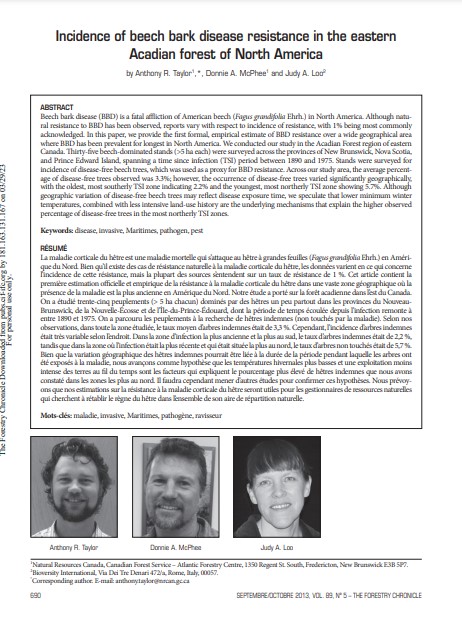Incidence of beech bark disease resistance in the eastern Acadian forest of North America
Bosque Modelo:
Nova Forest Alliance
Temática:
Conservación
Tipo de documento:
Artículo científico
Resumen
Beech bark disease (BBD) is a fatal affliction of American beech (Fagus grandifolia Ehrh.) in North America. Although natural resistance to BBD has been observed, reports vary with respect to incidence of resistance, with 1% being most commonly acknowledged. In this paper, we provide the first formal, empirical estimate of BBD resistance over a wide geographical area where BBD has been prevalent for longest in North America. We conducted our study in the Acadian Forest region of eastern Canada. Thirty-five beech-dominated stands (>5 ha each) were surveyed across the provinces of New Brunswick, Nova Scotia, and Prince Edward Island, spanning a time since infection (TSI) period between 1890 and 1975. Stands were surveyed for incidence of disease-free beech trees, which was used as a proxy for BBD resistance. Across our study area, the average percentage of disease-free trees observed was 3.3%; however, the occurrence of disease-free trees varied significantly geographically, with the oldest, most southerly TSI zone indicating 2.2% and the youngest, most northerly TSI zone showing 5.7%. Although geographic variation of disease-free beech trees may reflect disease exposure time, we speculate that lower minimum winter temperatures, combined with less intensive land-use history are the underlying mechanisms that explain the higher observed percentage of disease-free trees in the most northerly TSI zones.
Información Bibliográfica
Autor:
Taylor, Anthony R.; McPhee, Donnie A.; Loo, Judy A.
Revista:
Forestry Chronicle
Año:
2013
N°:
5
País :
Canadá
Páginas:
690 - 695
Volumen:
89
Idioma:
Ingles
Palabras claves
disease, invasive, Maritimes, pathogen, pest





